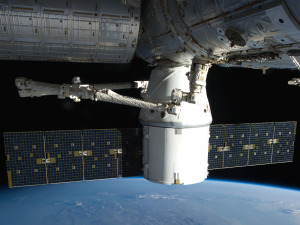ISS power glitch delays Dragon launch

WASHINGTON — A power problem on the International Space Station has postponed the launch of a SpaceX cargo spacecraft by at least two days, pending an effort to fix the issue.
NASA announced April 30 it had asked SpaceX to delay the launch of a Dragon cargo spacecraft on a Falcon 9 rocket that had been scheduled for May 1. The launch is now scheduled for no earlier than May 3 at 3:11 a.m. Eastern.
The announcement came a day after part of the station’s power system malfunctioned. NASA reported that one of the four main bus switching units stopped working April 29, and efforts to restore its operations were not successful.
The units take power from the station’s solar arrays and route it into eight channels that run through the station. The failed unit means two of those eight channels have no power. “It effectively loses one quarter of the power to the space station,” said Bill Gerstenmaier, NASA associate administrator for human exploration and operations, during an April 30 presentation to a joint meeting of the Space Studies Board and Aeronautics and Space Engineering Board here.
That failure hasn’t affected operations of the station, he said, but it does mean a loss of redundancy for some key systems, including the Canadarm2 robotic arm that will be used to grapple and berth the Dragon spacecraft when it arrives. “We don’t want to get SpaceX to station and then have the arm grab SpaceX and then have a power failure,” he said.
The delay in the cargo launch will give controllers an opportunity to restore the station’s power system by replacing the failed switching unit. Gerstenmaier said controllers will use the robotic arm to replace the faulty unit on May 2. If successful, the launch will be able to proceed May 3, with berthing two days later. A weather forecast issued April 30 calls for a 60 percent chance of acceptable weather for a May 3 launch.
This is not the first time a main bus switching unit like this has malfunctioned, with the unit repaired in orbit in one case. “These are just lifetime issues,” he said, adding that are a number of spares available. “It’s become pretty normal for us to take these failures in hand, figure out how to rejuggle manifests and just keep running.”
The Dragon spacecraft is carrying about 2,500 kilograms of research payloads, supplies and other equipment for the station. The science payloads range from “tissue chip” biomedical experiments to the Orbiting Carbon Observatory 3 experiment that will be mounted on the exterior of the station.
Gerstenmaier emphasized in his comments at the board meeting that the power issue has not affected station operations. During a broadcast session April 29 when station astronauts talked with students, he said he was the only one to notice that some of the lights in the Kibo module, where the astronauts conducted the broadcast, were turned off because of the power issue.
“It made for a nice ambience,” he said of the reduced lighting. “We’ll probably do that in the future.”
from SpaceNews.com http://bit.ly/2V7UMaI
Comments
Post a Comment